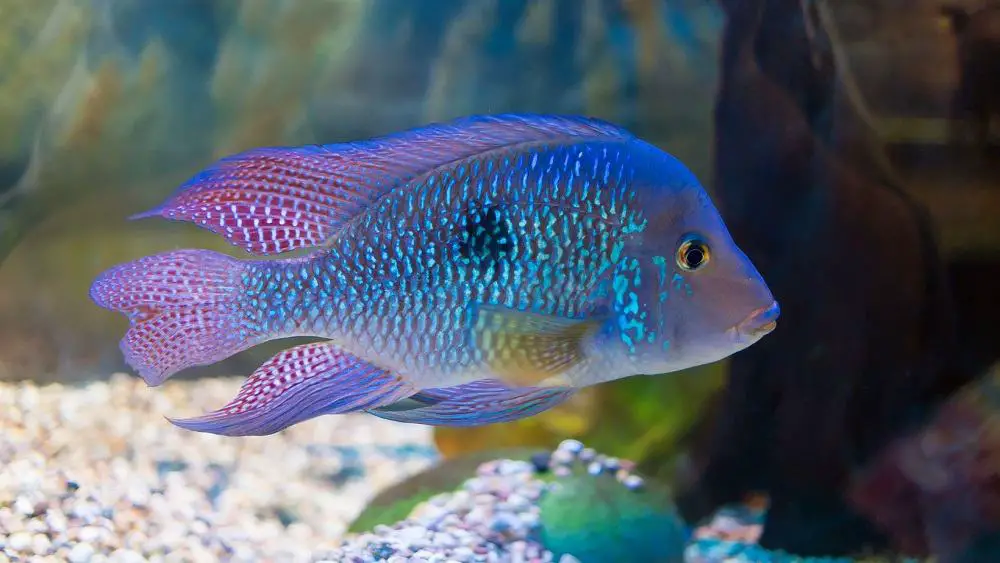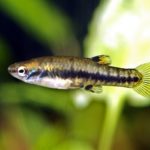South American Cichlids are a popular variety for aquarium lovers everywhere. This diverse breed differs greatly depending on species and can be found across the Continent of South America.
The Amazon River contains thousands of these fish, where the water is soft and pure. Their color and size make them a favorite for aquatic lovers and make great displays for aquariums.

Cichlids make for a fascinating study, learning about them is full of surprises. Read on for more information on this awe-inspiring fish.
Species Summary
Cichlids come in various shapes and sizes, and there are several types of different varieties.
Such as:
- Green Terror
- Oscar
- Festive
- Discus
- Angelfish
Each has their own set of characteristics, but generally they’re intelligent fish, some of them are peaceful whilst others tend towards aggression depending on the environment. Some require specific water conditions, whilst others are fairly hardy and easy to keep happy. Each variety has interesting colors and patterns and makes a great addition to aquariums. Sadly, these fish are threatened in the wild due to overfishing and some farming methods.
So, what else do we need to know about these fish and how to care for them? Read on for further information.
Care Guide
Tank Size
Tank size is dependent on what Cichlids you decide to purchase, however if you decide to invest in a community you’ll need a tank that’s 1.8 m/6 inches (ca. 15 cm) minimum. Larger Species would cohabit well.
If you decide to get smaller Cichlids such an Apistogramma they are best kept alone, so a tank that’s 1.2 m/4 inches (ca. 10 cm) will suffice.
Tank Mates
Most Cichlids are able to live with other Cichlids because they do have an aggressive streak, Any non-Cichlid tank mates have to be super confident and fast, so they can combat any conflict.
Catfish are able to reside with Cichlids as they are large and speedy so make good sparring partners, and the slower Catfish are great at hiding.
Fish that are described as ‘Bottom Feeders’ also make good companions for Cichlids, they have spines to ward off any attacks and aren’t very sociable so will keep themselves to themselves.
Same Species Tanks
You may choose to keep the same species together; however, professionals suggest mixing it up to avoid any bullying behavior. They aren’t very loyal to their own kind and will pick on lonely fish for their own amusement.
Water Parameters
South American Cichlids typically inhabit acidic, soft waters in their natural habitat. A tank’s pH should be 6.5-7.4 and if you’re adding Catfish it’s important to test the water regularly. Water temperature can be kept at 65, although they are more comfortable in waters between 75 – 80 degrees.
Cichlids produce more waste than most fish, so an effective water filtration system is vital to keep them in tip-top condition.
What To Put In Their Tank
In the wild, Cichlids reside amongst bountiful amounts of bog/driftwood as well as dense vegetation. To replicate this, a variety of sand and rocks should be placed in the tank. When arranging the tank, be sure to place rocks at the bottom with enough gravel to help prevent the fish from attacking it.
You can place aquatic plants in the tank but bear in mind that some Cichlids may dig them up and eat them, so be sure to investigate personality traits of the species you will be keeping.
Fluorescent lighting can be used in the tank as long as it doesn’t add too much extra heat. LED lights are a better option and can be brighter to light up the fish to observe their beautiful colors.
Common Diseases
Cichlids are susceptible to all the common diseases generally threatening marine life, but some are more prevalent than others. Head and Lateral Line Disease seems to affect larger Cichlids which, if isn’t treated, causes tiny holes above the eye and can develop into large cavities as it gets worse. Studies have suggested that the disease is caused by lack of nutrition, bad diet, poor water or too many chemicals.
The illness can be treated by addressing the above issues. You may need to move the fish to a different aquarium and completely change the water. Of course, prevention is better than cure, so ensuring fish are well-fed and looked after will help reduce the risk of them developing Line Disease.
Food & Diet
Cichlids are classed primarily as carnivores or pismires that dine on worms, smaller fish and insect larvae. They’re also partial to the odd plant-based meal which provides much needed nutrition.
Kept in an aquarium, Cichlids can be fed frozen and specialized fish food, pellets or live food. They should be fed in small amounts, thus avoiding waste. Providing supplements will help prolong their lives and reduce risk of illness.
Lifespan
Depending on species, Cichlids can live up to 20 years in captivity. They can live a long and happy life when kept in an aquarium, but conditions must be favorable for longevity.
Appearance
Cichlids come in all shapes, sizes, and colors. Colors vary depending on species, and some have translucent skin. Most species possess a rounded tail, a pointed fin near the pelvis and a long dorsal fin.
The dwarf Cockatoo is known for its blood orange fins that change color during breeding. The popular Blue Acara is a favorite to collectors due to its captivating blue color.
Size
South American Cichlids come in varying sizes, the smallest being only 3 cm or 1.8 inches (4.57 cm). And largest can grow to as long as 50 cm/19 inches (ca. 48 cm); they don’t generally grow larger than 3 feet (0.91 m)/91 cms.
Behavior & Temperament
Most Cichlids are a tad territorial by nature. For example, German Blue Rams can be aggressive but mostly with other Cichlids, so they can be kept with other peaceful fish.
In the wild, Cichlids are territorial and defend territory for the purpose of breeding. Fighting behaviors have developed as a survival mechanism. There is often discord amongst 2 females and 2 males. It’s not unusual for two fish to be swimming around each other in an attempt to claim as their own a rock or object nearby.
As a rule of thumb if a Cichlid is swimming up and down/to and from the tank they are likely to be angry and displaying aggression, but if they are shaking their fins and tails it’s a sign of flirtation and a female is likely nearby.
Breeding
Breeding Cichlids are fascinating and involve unique courtship rituals. They appear to dance, and dominant males perform cheeky little movements and chase the females and males in the tank.
The mating male will become more and more aggressive towards the others and attempt to keep them away from the female by puffing up and swimming towards them.
The male will often prepare a breeding location at the bottom of the tank near a rock in readiness for eggs. When a female drops her eggs, you’ll notice that they are tiny and barely visible.
One tell-tale sign of this is that the female will wave her tail in a fast manner. Cichlids are mouth brooders, so they will suck eggs back into their mouth.
The male will expose his spots in a crazy dance-like manner as she follows him as he fertilizes the eggs she’s holding in her mouth, where they will stay until hatching time. Some South American Cichlids are substrate spawners, whose eggs develop outside.
Cichlids make fantastic parents and look after their young from day 1.
They fiercely defend their eggs and stop potential predators from killing them. They fan the eggs to aretae them and can even identify any eggs that are diseased and pick them out to protect the others.
Their parental duties don’t end after the fry hatches. They continue to guide them by keeping them together in groups, keeping a watchful eye for danger.
Gender differences: male vs. female
Although there are many differences in species of Cichlids, there are a few features they share in common. Males have slimmer but larger bodies, and females have much brighter colors. Male fins are larger and less rounded than a female.
Fun Facts
The largest Cichlid is thought to be 3 ft (0.91 m) long (90 cm)
New species of Cichlid are discovered every year, and currently there are more than 1,700 known species.
The Dwarf variety of Cichlid are actually soft and quite shy, unlike thor non-dwarf counterparts
Some Cichlids change the body color to communicate with others
Some studies have revealed that at least 16 species produce vocalizations
Some Aquatic specialists have discovered that they can change the sex of species by altering temperatures or adding hormones to the tank
The most common species of Cichlids is the Angelfish
6 species are thought to be extinct
They only have one nostril
Some of them have more than 3 anal spines
The South American Cichlids are indeed an interesting fish,and it isn’t surprising that aqarainists everywhere seek out the Cichlids to add to their tanks.








